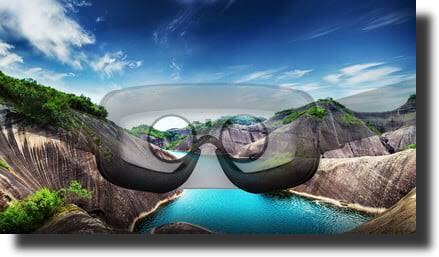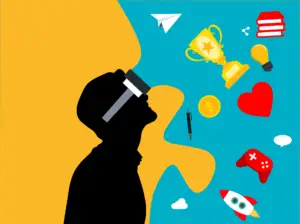Virtual reality is best defined through the moments—or rather the memories—of the things you feel or experience when you have that headset on.
When you put on the HTC Vive and experienced virtual reality headset for the first few times:
- You can play fetch with a robot dog in a futuristic laboratory.
- You can throw a baseball cap into the sun.
- You can leap away from the low groan of a zombie behind you.
- You can even try to use your virtual hand to scratch your real nose when it is itchy you.
In Virtual Reality (VR), you become an effective participant in an environment completely removed from reality. And that’s what gives VR a different experience from watching a movie or even playing a video game.
Unlike the various forms of media that we have, virtual reality blocks out the rest of the world so that it doesn’t just encourage us to suspend our disbelief but actually takes our senses to a whole new level immerses us wholly in the experience.
From the outside world, bystanders will see someone putting on a headset, wearing a smile, or a serious, focused expression on their faces, and waving their hands around.
This is what VR looks like to people on the outside world:

But to the person putting on the headset, they’re fully drawn into a whole other world, where they can see and interact with their environment in such a way that isn’t possible in any other medium.
This is what they see:

It’s easy to be very skeptical about virtual reality if you haven’t tried it yet. After all, experiments at virtual reality go back to the 1960s, all of which just never caught on. However, in the case of today’s VR, after trying some unique experiences, it was clear why Facebook had to spend about $2 billion to acquire the Oculus Rift virtual reality system back in 2014.
There are two kinds of people in this aspect: Those who think VR will change the world and those who haven’t tried VR.
Words don’t always do justice. The best way for you to understand virtual reality is to experience it yourself. And the second-best way is to understand VR is probably to understand what it is and used for.
What Virtual Reality is not
Before I gave VR a try, I had already formed this (inaccurate) opinion about what it’ll be like. And after correlating my experience with others, I realize this is a mistake that a lot of people out there will make.
Virtual Reality isn’t a fad.
VR is not “just for gamers or people who just like having a wild imagination” it isn’t “like having a small TV on your face,” either is not ” the next step after 3D movies.”
VR is an upcoming breed of technology that will have to take some time to fully take root—like in the case of the automobile or even the personal computer.
We can depend on technology to grow exponentially—how well we embrace that technology; however, it depends on many other variables. But unlike the smart wristwatches and other considerably new devices, there’s more buy-in around VR —from Google’s Cardboard, Facebook’s Oculus, Valve’s Steam, HTC’s Vive, and Sony’s Playstation VR. We can expect the adoption to be very smoother and faster than it was for other emerging technology.
And that’s a promising thing because virtual reality isn’t just an incremental step up in terms of innovation. It’s a huge step forward.
Google’s Cardboard and the HTC VIVE are virtual worlds apart.
There are two very different VR experiences you can try right now.
One is inexpensive and accessible, consisting largely of 360-degree videos. You might have encountered these on Facebook or YouTube. You slot in your smartphone into a Google Cardboard, Samsung Gear VR, or another headset, start up a compatible VR app, and put it on. Your smartphone’s accelerometer enables your point of view to correspond with the movement you do with your headset.
Considering its remarkably low price, Google’s Cardboard VR headset isn’t a bad way to get started or a small taste of VR in its most rudimentary form. But it doesn’t quite compare to the experience you get from the true VR.
Virtual Reality (VR) is not the same as augmented reality (AR)
You’ve probably must-have experienced augmented reality before, especially if you’ve used Snapchat’s filters to vomit rainbows or swap faces with a friend or even play the Pokemon Go game on your phone.
Augmented reality (AR), as the name implies, augments reality by applying a layer over your view of the real world you are directly looking at; you’re Like a heads-up display (HUD) AR improves your perception—it doesn’t try to replace it entirely.
On the other hand, virtual reality removes you from real the world, and that’s what affords it a level of immersion we’ve never been able to accomplish before.
And while it’s possible to combine the two so that parts of what you see are brought out from the real world which you are in and parts of it are virtual making you feel you’re in another world entirely, the full immersion you get with the “true VR” is what makes it drastically unique from anything else you’ve tried.





